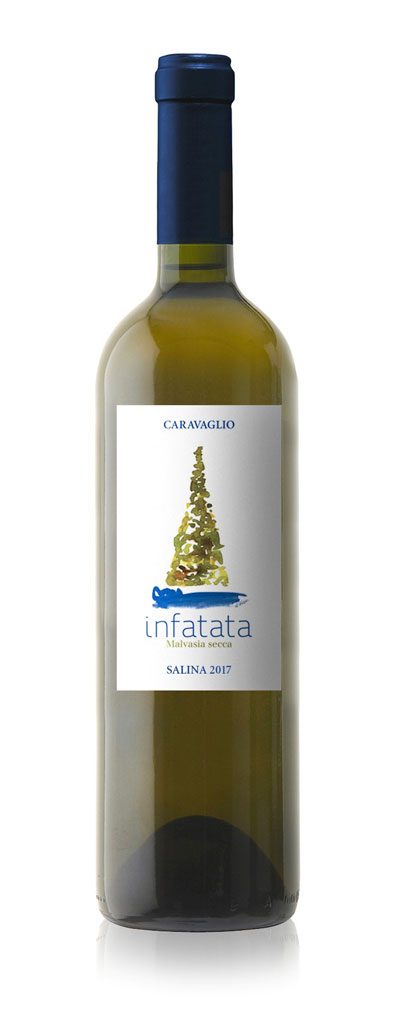Click here for orders and more information
The focus on local grape varieties, organic farming and the choice not to add yeasts, are the three crucial components to obtain a territorial wine.
A wine that captures the essence of the land it comes from.
Controlling temperature and the tendency to use ever-decreasing amounts of sulfites are the only tools Nino uses to help nature express itself at its best.
It is the unique characteristics of this volcanic land surrounded by the sea, which must prevail in the taste, without being overwhelmed or influenced by other aromas such as that of wood or of a grape variety that does not have its historical roots here.
The pearl of the history of Salina and of the Caravaglio Winery is the sweet Malvasia delle Lipari DOP wine, with which Nino has also won numerous prestigious awards.
Very important was the choice of vinifying Malvasia grapes as a dry white wine, a wine to drink throughout the meal, but with high quality characteristics.
Nino’s exploration continued by testing Malvasia in terms of longevity, producing wines by macerating the grapes, obtaining spectacular results that are highly appreciated by international experts.
The grapes traditionally used in the area also include many red-berry varieties that allow him to continue discovering other great Aeolian gems.
 |
Malvasia delle Lipari
The Malvasia straw wine represents the history of the Aeolian Islands. It was a royal wine in the major courts of Europe until the early 19th century. Phylloxera, emigration and world wars nearly made it disappear. Tasting notes: Amber-colored with golden glimmers, bright and clear. It holds a collection of aromas: dates, dried apricots, figs, raisins, vanilla. Elegant freshness for a straw wine that is not syrupy. Persistent final note with a hint of lemon zest. |
||||||
|
|
|||||||
 |
Salina Bianco
A dry white wine obtained with Malvasia di Lipari, a grape variety that represents the history of the Aeolian Islands. 90% Malvasia di Lipari and 10% other local varieties, grown in the total respect of nature, in 20 small vineyards located in areas with sandy and volcanic soil, on the island of Salina. Tasting notes: white flowers, citruses and herbs, savory. Relevant freshness |
||||||
|
|
|||||||
 |
Infatata
This wine is born from Malvasia di Lipari grapes that are grown completely respecting nature, in the Tricoli vineyard. Tasting notes: The first aromatic impression is elegant: white flowers (jasmine) are followed by fruit (apple and grapefruit) to then shift to fine herbs. |
||||||
|
|
|||||||
 |
NERO DU MUNTI 2016
The Corinto Nero, just as the Malvasia di Lipari, is a native vine of the volcanic Aeolian Islands. In this case it is pure and harvested form the vineyards on the island of Lipari, which are located in an old crater called Fossa del Monte (pit of the mountain). Tasting notes: Intense ruby color, red fruit flavors: cherry, blackberry, pomegranate, a hint of spices, elegant tannins. A balanced wine. |
||||||
|
|
|||||||
 |
Occhio di Terra
|
||||||
| Type: | Macerated white wine |
| Appellation: | Salina IGP. |
| Grapes: | 100% Malvasia |
Occhio di Terra Malvasia is a dry white wine, a real marvel of scents that are delicately disclosed as you open the bottle. In this case, the grape variety "Malvasia di Lipari" is pure, powerful and finely expressed.
The name literally means "Eye of the earth", referring to the vineyard, which is a piece of land that is particularly rich and generous.
The grapes are harvested on the first week of September. The wine ferments with its skins at a controlled temperature. The must-wine remains in contact with its skins for about 30 days. After the alcoholic fermentation, follows the malolactic fermentation. The obtained wine stays on its fine lees for about 6 months. After that, the wine is racked and lightly filtered to be bottled.
 |
Chianu Cruci
|
||||||
| Type: | Macerated white wine |
| Appellation: | Salina IGP |
| Grapes: | 80% Malvasia 20% Catarratto |
Chianu Cruci is the name of a part of Valdichiesa, a beautiful valley between the two volcanoes of the Island of Salina. Among the white wines produced by Caravaglio, this one remains the longest on its skins. 80%
Malvasia grapes and 20% other local grapes with white berries are used for this wine. They are harvested on the second week of September. The grape is then destemmed and left to macerate.
After a month of maceration, the skins are separated from the wine, thus obtaining half of the original volume. The wine then rests and goes through the malolactic fermentation.
Spring is awaited to then rack the wine in order to get rid of any sediment and bottle it.
 |
Palmento di Salina
The Palmento di Salina wine shows a bright red |
||||||






